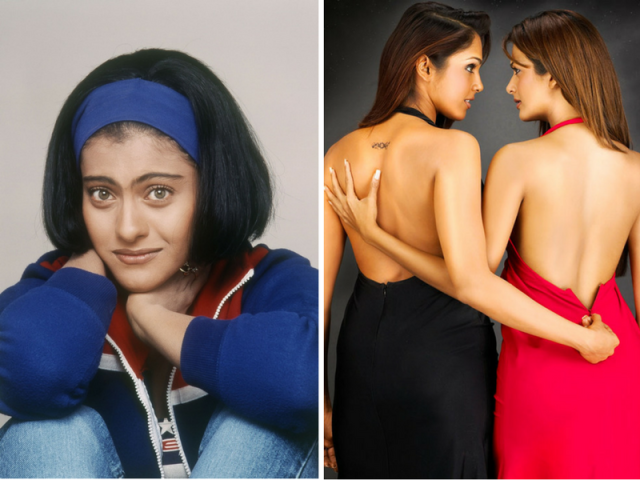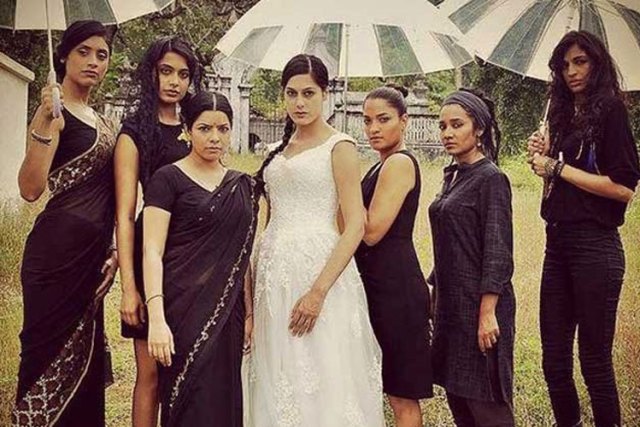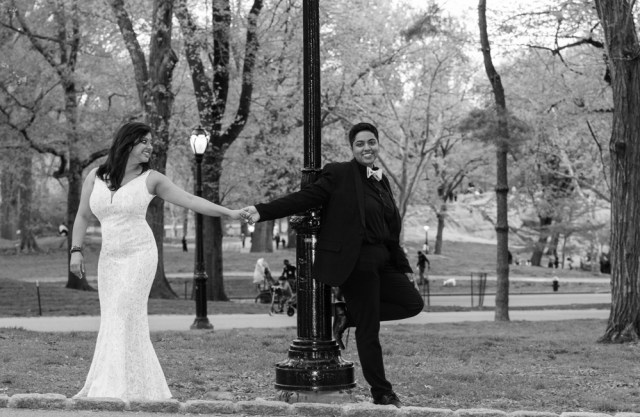Between my parents’ house in LA and my apartment in NYC, I have a collection of at least 50 Bollywood film posters buried in my closets (pun intended). I still have heavy, glass-framed posters of Kuch Kuch Hota Hai and Dilwale Dulhania Le Jayenge, classic romance-drama films of the 90s, hanging in my childhood bedroom. My obsession with Bollywood goes as far back as I can remember (and then probably before that, too.)
Looking back, I chalk up this obsession to a plight that plagues me more and more as an adult — the unquenchable thirst of wanting to see someone like me on television, in movie theaters, and on the pages of novels that line my bookshelves. When I was younger, this meant I wanted to see a South Asian woman who found love and acceptance against all odds. Later, as a young adult coming out as queer, this meant yearning for so much more: love and acceptance, sure, but also validation of both my desires as related to people of all genders and my choice to don short hair and wear men’s clothes.
All of which is to say: I needed to know it was possible to be a South Asian queer woman who could find love and have a “happy” ending.

Left: Kajol as tomboyish Anjali in Kuch Kuch Hota Hai, Right: Isha Koppikar and Amrita Arora in Girlfriend
What I learned from this cinematic medium that taught me to be fluent in Hindi just about the same time I learned English was that someday, against all odds, my knight in shining armor would win the approval of my family and marry me in a multi-day, multi-event big, fat, Indian wedding. As I grew into my intersectional identities, I thought my queerness meant this would all vanish, that somehow my Bollywood ties to my parents’ roots would be severed by the deviance of my desires. Instead, part of accepting my identity as both queer and South Asian has meant revisiting Bollywood in search of female presences that both entice and inspire me. Unfortunately, Bollywood has left much to be desired in this regard.
In the ’90s, Hindi cinema began to scratch the surface of LGBTQ depiction with caricature-like portrayals of gay male characters who were effeminate (and therefore “less” than the cis-hetero men who sidelined them) and/or hypersexual (striking fear in those around him that they would fall prey to his frivolous ways). These gay men were, therefore, misfits who became the butt of all jokes. From roles as the only one in a group of friends who’s worse at sports than his “manlier” friend (like in Pyaar Kiya Toh Darna Kya), to design-privy fashion icons (as in Fashion), and single, older, hypersexual males like Boman Irani in Dostana and Rishi Kapoor in Student of the Year, Bollywood depictions have made gay men the epitome of stereotypes. Through it all, these characters most often never openly identify as gay, nor are they portrayed with any other layer of identity (or humanity).
Despite India’s own troubled past with the criminalization of same-sex relations (first de-criminalizing and then re-criminalizing colonial-era Section 377) these terrible depictions easily became Bollywood’s flag of visibility for a community that not only has more depth in individual identities but that span more identities than just cis gay men.
On my own journey, I discovered many loves, in the forms of both female characters I resonated with, as well as those whom I wanted to emulate.
The first of these was Kajol, star of Kuch Kuch Hota Hai and countless other classic romance-dramas of the ’90s. In KKHH in particular, Kajol portrays Anjali (second only to Rahul as the most overused name in Bollywood), a tomboy-ish short-haired woman who loves basketball and is, essentially “one of the guys.” This trope plagues her when she falls for her best friend Rahul, when he is instead in love with Tina, the short dress-wearing, beautiful girl on campus. Anjali even goes so far as to try wearing makeup and dresses to fit in with girls like Tina, but is mocked endlessly. I related much to Anjali, basketball to non-girly clothes — so much so that for a period of time, I thought I too could blossom into a more femme (and therefore more desirable) woman eight years after college and finally end up with my first love.
Later came Fire, a film I discovered years after its release. The two female leads find love with one another after differences and abuse from their husbands (who are siblings). Though groundbreaking in its depiction of love between two women, which I found immense resonance with, it was also a story that showed this love as the byproduct of misogyny and failed straight relationships. This wasn’t my story, and though its desire lit a fire in me, it wasn’t something I could look up to, or even point to within my community as a means of understanding my lifestyle.

Angry Indian Goddesses
Then came Girlfriend, a film that was open about its lesbian angle. In it, a love triangle develops between two female friends, Tanya and Sapna, and Sapna’s boyfriend. Tanya is shown as jealous and overprotective of Sapna, to the point of obsession and violence. Eventually, her psychosis marks her end, showing me, and lady-loving Indian girls like me that lesbians were literally crazy.
Bollywood has since moved the needle, albeit a little bit. First, there is a subjective understanding of feminism being a concept, and the mainstream success of films like Queen show this. Showing the self-reflective journey of a woman whose marriage falls through, Kangna Ranaut displays the kind of independence that I strive to embody by being as out (and unreliant on men) as I am.
There have also been progressions with male gay depictions, with strong, multi-faceted characters in Kapoor and Sons and Aligarh. Where the first dealt with a gay man’s very real and internalized struggle about coming out to his family, the second showed the true story of a gay professor in the city of Aligarh who was outed and ostracized thereafter. Both depict these characters as people with more to them than just their same-gender attractions, eliciting relatable humanistic struggles around conformity, and the privilege (and burden) of being out.
And finally, in 2015, the movie Angry Indian Goddesses was as close as ten-year-old me could’ve gotten on the journey of self-acceptance. Upon the premise of reuniting for a bachelorette party, seven women gather in Mumbai and find out that two of them, Freida and Nargis, are the ones getting married. The movie touches upon issues of gender equality and the treatment of women in a patriarchal society, while also weaving strong female characters, the importance of female bonding, and a female-female relationship that is treated with dignity and grace. In the end, this relationship is not what defines either the movie or its characters —and though neither had hair as short as mine, I reveled in the completeness and relatableness of both the women-loving female characters and the straight ones.

Priya and her partner in Central Park, NYC (Photo Credit: Grishma Patel)
I don’t put up as many Bollywood posters on my wall as I used to; my apartment walls instead adorned with pictures of my partner and I as well as her acrylic paintings of everything from landscapes to peacocks to beautiful women. My life now consists of creating and capturing real life narratives forward for young Indian girls like me who still seek holistic portrayals of queer South Asian women. I believe that for my family and friends, the simple act of being out is resistance in and of itself.



I love this! And thanks, too, for being the representation you want. This article is not a Bollywood film, but I love your masculine-of-center South Asian representation. I love that picture of you and your partner!
AHHHHHHHHHH this is so COOOOOOOL!!!!!!!
in all seriousness this means the world to the tiny little me who grew up watching Bollywood films while my mother told me all about my future husband lmao
Priya thank you. I always thought Chakde India had subversive queer undertones. Love that film. Also Heroine with Karina Kapoor. We need more representation in Bollywood…one day!
thank you so much for this! i just added angry indian goddesses to my netflix list.
As a South Asian queer woman, thank you. Thank you so much for this.
I also had such a huge crush on Anjali (Kajol). I mean, what Desi queer girl didn’t? And I always somehow knew I could never actually tell anyone that out loud. And then OH MY GOD “FIRE” CAME OUT. I remember watching it in short bursts whenever my parents weren’t home, straining to listen for the garage door to hum telling me my parents were home and it was time to change channels as fast as I possibly could lol.
And, although I was super excited to watch “Angry Indian Goddesses,” and was SO excited with the queer plot twist because I had no idea what the movie was about before I started watching, there were certainly some problematic aspects to it. Part of progress I suppose. But overall, it’s so exciting to see depictions of queer people slowly creeping into more Bollywood movies. And before the Internet, I had no idea other Desi queer people existed. I really hope queer Desi kids today know what’s around them.
On another note, I often wonder if I’m alone in this. I dated another South Asian queer woman a few years ago and it was not the best relationship, which had nothing to do with her being South Asian. If I’m completely honest, I think part of me stayed in that relationship *because* she was South Asian. I thought that her being South Asian would partly alleviate the huge disappointment my parents were about to feel. Like, I was enough of a disappointment to my parents for being gay. The least I could do is be with an Indian person for them so it wouldn’t be as foreign. This was a very, very bad idea. The relationship was tumultuous to say the least. She’s a great person but both of us had a lot of growing to do and, at the very least, we met at the wrong time in our lives. The relationship lasted 2.5 years. It seems so ridiculous to me now to think that I could endure a relationship like that just to ease my parents’ process but it made complete sense at the time.
Anyway, Priya, thank you again so much. You and your partner are so beautiful and it seems like you’ve got a great life together. Thank you so much for writing this! It’s kind of amazing to see another queer Desi out there <3
Welcome to AS, Priya! I love this and also I am SWOONING over your wedding photo. If that’s ok. :-)
I have mixed feelings about Bollywood in that I feel like I’m the only South Asian I know who doesn’t much care for it. Their songs are fun to dance to (and Trikone floats in pride parades are the best floats because we know how to party) but the movies just feel unrelatable. I grew up outside Bangladesh in a city where the only other Bangladeshis asides from my family were my aunt and uncle a couple of hours away, and I was never really raised as particularly any culture – but even amongst my massive family tree I stick out as a foreigner. So Bollywood felt as foreign to me as maybe Hollywood did, but at least Hollywood didn’t come with expectations that I should find it more relatable or that I should be automatically a fan because it’s “my people”.
Even now in queer South Asian circles it feels kinda weird when people are being nostalgic about Bollywood. I appreciate this piece because you also seem to express mixed feelings about the whole endeavour. I just wish there were more discussions abotu South Asians in general, especially by other South Asians, that didn’t try to claim that we were all united because of Kajol or Aishwarya Rai or something.
I feel ya on this. I don’t speak Hindi so I’m not super big on Bollywood movies. I think Kajol was the only one I had actually was attracted to.
But yay for Trikone :) Hope to see you at a future event!
There’s no Trikone in Melbourne ?
Welcome to AS Priya. Good to see this article.
Liked this specially- I believe that for my family and friends, the simple act of being out is resistance in and of itself.
I do have a longish post about some of the movies you referenced here :-)
Dilwale Dulhaniya Le Jayenge- I saw this and had so many issues with it. First, the guy stalks the girl, hounds her, and in his relentless pursuit even after her saying ‘no’, gets her to say ‘yes’. Second, when she suggests that they run-away, he turns a blind ear once again, telling her that he will only marry her with her Father’s blessing! He doesn’t for once consider her as a person with feelings, thoughts, ideas of her own! Then there is that Karwa Chauth itself (Kadwa Sachh-bitter truth, I think myself), that troublesome tradition that was entrenched in numerous married women along the years as something to be followed to keep their husbands safe and long. To get unmarried women take it up to get a ‘good husband.’ It was practiced before, but this one movie ‘sealed it’ with their mindsets.
Note- To those un-initiated, Karwa Chauth is a festival when a married woman fasts from sunrise till moonrise and can break the fast only after seeing the full moon and then sees the husband’s face through a sieve.
Anjali in Kuch Kuch Hota Hai was refreshing to start with, but her journey became troublesome. She becomes this girl who blossoms into a femme as you put it. The director has many years later said that he should have treated Anjali’s story arc better.
Fire….was also a story that showed this love as the byproduct of misogyny and failed straight relationships- Yes, but isn’t it also the truth of a lot of women? Isn’t it also true that the experiences of our lives moulds us, shapes us? Make us take those decisions for whatever reasons? That said, with all its clichés, it was its own story, someone’s story perhaps.
There are a couple of more movies that has some subtle lesbian undercurrents in them. They were more enjoyable for me to watch. Mandi is one such masterpiece. The other is Razia Sultan where there is a lingering undercurrent between her and her hand-maiden. To think that she ruled the ‘Delhi Sultanate’ more than 800 years ago!
im not southasian, but german, nevertheless i adore some of the bollywoodmovies,because they made you forgot your Troubles for 3 hours.
Even though i see some of the negative sides, the portrayal of women esp. nonetheless .
i adore kajol as well esp in kuch kuch hota hai,who could resist her , really….
her bubblyness roles makes me wish that they had a Bollywood sequence in buffy`s Musical Episode”once more with Feeling” cause in some ways her bubbly-ness reminds me of willow, esp in the season 1-3, when her nervous fast talking was much more distinct. tara with her calmness could be Rani Mukerji.
i do remember , actually from india,margarita with a stray about a Young handicapped woman falling in love and having a RL . watch it if you dont know it.
then i remeber nina heavenly delights, Chutney Popcorn , the journey, the world unseen , i cant think straight. they re mostly produced in the UK, not from india. but independent and very clear lesbian films. with south asian women
oh and i think amber benson has These deep intense eyes that rani does have too.
I’m very late to this article, but I created an account just so I could comment on it. Everything you said really resonated with me and reminded me that are people like me out there. I’m glad you wrote this!